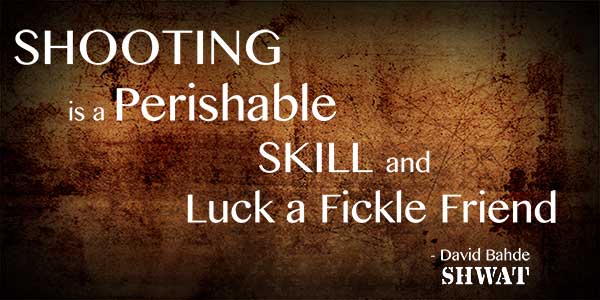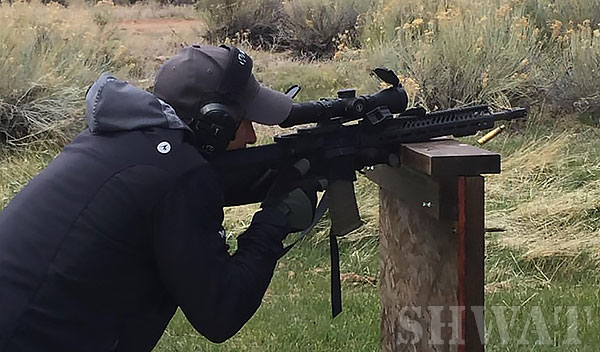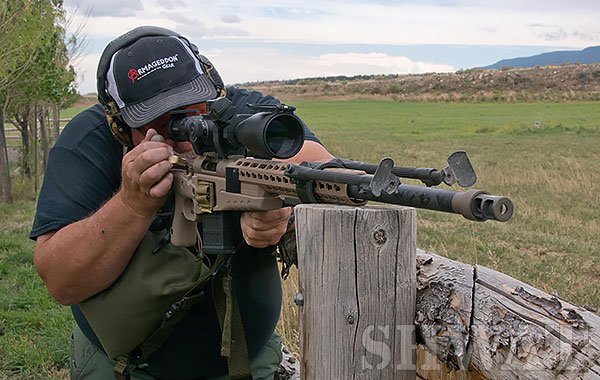
I am often asked, “What’s the difference between training and practice, isn’t it the same thing?” While the answer is an unequivocal “No,” it remains a very misunderstood difference, especially given the bombardment of “training” options offered these days. Many of these options are nothing more than babysitting or – worse – just a sales pitch in disguise. The reality has never changed, training and practice are different things. And for you, hunter, shooter, red blooded EDC American, it matters.
Decades ago as a new martial artist I continually referred to my attendance as “going to Karate practice”. Overheard, my instructor made it abundantly clear, “You better not be here to practice, you are here to learn. Practicing is your responsibility and must be done on your time.”. He explained the dojo is primarily a training hall where you learn from your instructors.
Firearms or tactical training is EXACTLY the same. Spending training time practicing is wasting both you and your instructor’s precious time, not to mention your money. You must practice on your own to progress; you attend training to learn what you need to practice. For me, it looked like this: I arrived early and left late cleaning the dojo and locking up so I could practice without cutting into precious training time. Put simply, “Training is what you attend to learn what you need to practice.” It was true then and remains true today whether it is a fighting art, sport, hunting or weapons and tactical training.
Training is Critical
Cute and pithy quips abound when it comes to training, any training, but especially martial training. “Beware the man with one gun…” “…One sword…” “A thousand cuts a day prevails over 100 cuts from ten swords,” Pick a version, it goes on and on. People have been making this stuff up for thousands of years. Some have truth to them, most are nothing more than fortune cookie philosophy made up by some dude sitting on his couch. It is a “meme” world and these are great memes.
Focus is critical, so the guy with one gun is great – until his one gun is useless under certain circumstances. Knowledge is critical, especially in the self-defense world. What you don’t know can and will get you killed, so learning just may save your life. This is what makes training invaluable, even if it tells you what not to do. Holing up in a room practicing “one” thing, or standing on the range performing incessant “drills’ only makes you an expert at drills and fighting a wall.
If you only fight in a dojo or square range you are good, otherwise you just may be screwed. Practice is essential, but you must train to determine what best to practice. That will change depending on your purpose, and the only way you know is to seek out training. And NO the Internet is not training, knowledge yes, but not training. You can see what to do, but nothing replaces guidance by a trained professional on when best to do it and how it’s best done. Experience comes two ways, trial and error on your part, or passed on from the experienced. Both are necessary, but learning from others saves all kinds of pain and may just save your life. It can also insure you win the next match or make that clean and humane shot on your next hunt.

Practice is Essential
Every instructor with even moderate experience has seen the person return to the next class having forgotten everything learned in the previous one. It’s a prime example of how useless training can be when void of practice. Returning to training for the purpose of “polishing up” is mostly a waste of your money and everyone’s time IF the purpose is to become proficient. I stress this because in many cases people are there for other reasons. For some it’s just fun, so have at it. Maybe they enjoy the interaction or company, that’s great. Some just like to plaster the walls with certificates, its America, that’s fine too. Just don’t expect to improve because you will always be behind the curve. If you spend the first three days of a week-long training remembering what you forgot from the last one you are really there for a two day class (If that). If you intend to progress, or implement what you learned in real life you MUST practice.
So exactly what is practice?
Practice consists mostly of repetitive implementation of the basic skills learned in training, most of which can be practiced at home, safely, with no need for any special facility. Every student trained in the last 40+ years who exceled did so because they practiced at home. Speak to anyone who excels at a martial skill and they will tell you most of their practice is not at the training hall. It’s true of most any sport or martial art, including shooting. For pistols, drawing from the holster, stance, grip, trigger manipulation, loads, reloads, even holstering can all be done dry, at home. Most every aspect of weapons manipulation can be accomplished without live ammunition. Sort out clothing and other equipment issues. Set up obstacles and barricades for rifle placement. Practice movement if there is room. It can all be done with dummy ammunition when needed, or a blue gun when not. There are even ways to practice scope use at short range that simulates longer range shooting. Short of recoil control and trigger manipulation under fire most all the basics can be practiced without the need for a range or even live ammunition meaning there is simply no excuse not to practice.
Hunting is no exception, especially if you actively hunt, meaning track and stalk game. There is no reason not to practice those skills in the off-season, without a rifle. Grab a camera, or these days take your phone, or just go for a hike with purpose. Short of hanging out in the hunting condo waiting for “game” to walk by, hunting requires great skill far beyond the trigger press. All of it can be practiced without a rifle. Get outside and work out avenues of approach, the best places game migrate, all the things that make hunting a skill, not just an event, none of which require a rifle.
Yes, safety is critical, so follow all the rules if you are practicing with a firearm. No live ammunition on or near you, or even in the same room, if possible the same floor or building. Constantly check your chamber for ammunition prior to starting the drill. If interrupted re-check for no ammunition. Start the entire safety process over prior to beginning if interrupted. Almost without fail accidents occur during dry fire due to being lax on safety or following an interruption. If at all possible point in on a wall that will stop bullets and practice where you cannot be interrupted, and continue to follow the basic safety rules. Best part of all, its free, you can do it for a few minutes every day, or longer once a week, it’s entirely up to you, just do it.
During live fire practice don’t just make brass by pressing the trigger repeatedly. Make it valuable by practicing sight picture, sight alignment and sight (or scope reticle) tracking. If you are allowed to, practice drawing from concealment, or your duty or competition rig, whatever you will use. Shoot from real world positions if you can, and if lucky enough, movement. If all you can do is shoot from the confines of a bench work on accuracy or shoot with your off hand, or off hand side. Hunters can practice hold overs and accuracy from less convention positions when possible. Shooting is not practice, practice involves purpose so use whatever propose you can given the confines of the range or its rules with safety being paramount. All the skills in the world mean nothing if you become lax on safety turning yourself into a headline or statistic.
Lastly, Gunfu is for the movies, and only a moron with a death wish does somersaults and cartwheels with their firearm. You want to practice Parkour or the latest fitness craze? Leave the gun at home.

Training is knowledge gained, so shut up and learn!
If you attend training for the purpose of gaining knowledge then do just that. You are paying a professional (one would hope) to teach you, so shut up and let them teach. If you are there to teach you have it backwards, start your own school or class. Listen, learn, try, go back to your home base and evaluate. If you like it and it works use it, if not discard it. While you are there enjoy yourself, interact with fellow students and the instructors. Ask honest questions on the breaks. If you attend with a closed mind you are just paying someone to give you commands on the range you could give yourself at home.
Much of training these days is brand and personality. It is not supposed to be a personality cult, but a learning environment. Having minions is great for evangelists, but it’s not a religion, so train outside the flock on occasion. It may surprise you just how much you learn, even if it’s just that your guru is truly the master of all. Knowledge is the key, gain all you can.
Does that mean you change what you done for the last five years? Not necessarily, but you may just learn something valuable. No one I ever interviewed after a shooting told me they wished they had been less skilled. Several said “I thought I would never use that, glad I knew it.”
Bottom Line
Proficiency in most anything requires both training and practice. Removing either does nothing more than decrease the likelihood of success. Attend all the training you can, then take what you learned and practice on your own. Practice however you can, safely, in preparation for the next training where what you learn becomes that much more valuable. Shooting is a perishable skill, and luck is a fickle friend. It does not always favor the unskilled, it mocks them in death. At the risk of uttering some fortune cookie philosophy, “Fortune favors the prepared,” and preparation means both training AND practice.

